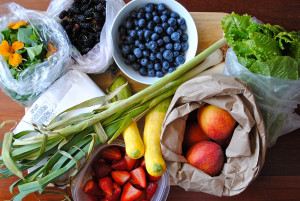As we’ve moved into the Autumn months, our focus shifts from the lighter foods of Summer to heartier fare. The weather is cooler but your produce choices are heating up. We move from the water packed fruits and vegetables to the denser and root based varieties.
These amazing superfoods are either hitting their peak in the garden or can easily be found in your local farmers market or grocery store.
Here are some of the season’s best…
Apples
Sweet or tart, apples are satisfying eaten raw or baked into a delicious dish. Just be sure to eat the skin-it contains hearty-healthy flavonoids. Health benefits include:
• Full of antioxidants
• 4 grams of dietary fiber per serving
Harvest season: August-November
Brussels sprouts
Made the correct way, these veggies taste divine. They have a mild, somewhat bitter taste, so combine them with tangy or savory sauces, like balsamic vinegar. Health benefits include:
• 1/2 cup contains more than your DRI of vitamin K
• Very good source of folate
• Good source of iron
Harvest season: September-March
Cauliflower
The sweet, slightly nutty flavor of cauliflower is perfect for winter side dishes. It’s wonderful steamed, but it can also be blended to create a mashed potato-like texture or pureed into soup. Health benefits include:
• Compounds that may help to prevent cancer
• Phytonutrients may lower cholesterol” “Excellent source of vitamin C
Harvest season: September-June
Dates
This Middle Eastern favorite is a sweet fruit that is perfect braised in stews, chopped up in desserts, or stuffed with cream cheese or almonds. Health benefits include:
• Low in fat
• Good source of fiber
• Good source of potassium
Harvest season: September-December
Grapefruit
The signature tartness of grapefruit provides a contrast to other citrus fruit. Add it to mixed greens, combine it with avocado and shrimp, or enjoy a fresh glass of its antioxidant-rich juice. Health benefits include:
• More than 75% of your daily recommended intake (DRI) of vitamin C
• Good source of lycopene
• Contains pectin, which has been shown to lower cholesterol
Harvest season: September-April
Kiwi
Use this sweet fruit to add a tropical flavor to your recipes. It’s great mixed with strawberries, cantaloupe, or oranges and can be combined with pineapple to make a tangy chutney. Health benefits include:
• More vitamin C than an orange
• Good source of potassium and copper
Harvest season: September-March
Pears
The sweet and juicy taste makes this fruit a crowd-pleaser. Cooking can really bring out their fabulous flavor, so try them baked or poached. Health benefits include:
• Good source of vitamin C and copper
• 4 grams of fiber per serving
Harvest season: August-February
Sweet potatoes
These veggies are for much more than Thanksgiving casseroles. More nutritionally dense than their white-potato counterparts, try roasting them-they’ll taste delicious, and you may maintain more vitamins than boiling. Health benefits include:
• Excellent source of vitamin A
• Good source of iron
• Anti-inflammatory benefits
Harvest season: September-December
Turnips
Tender and mild, these root vegetables are a great alternative to radishes and cabbage. To flavor these veggies, use fennel, bread crumbs, or even brown sugar. Turnip leaves, which taste like mustard leaves, are easy to cook and dense in nutrients. Health benefits include:
• The roots are a good source of vitamin C
• Turnip leaves are an excellent source of vitamins A, K, and folate
Harvest season: September-April



0 Comments